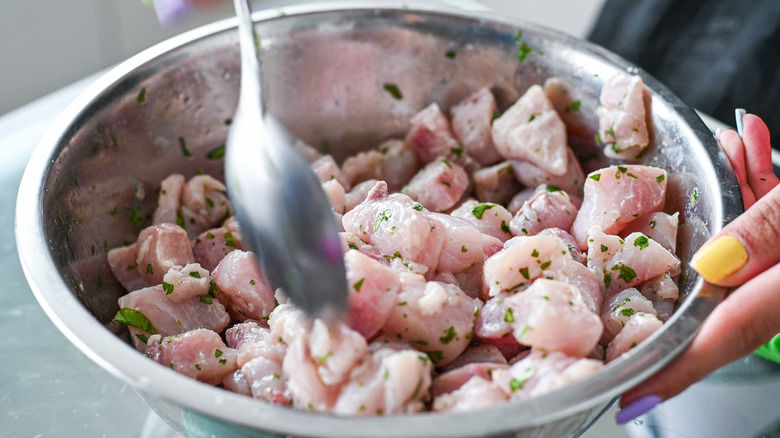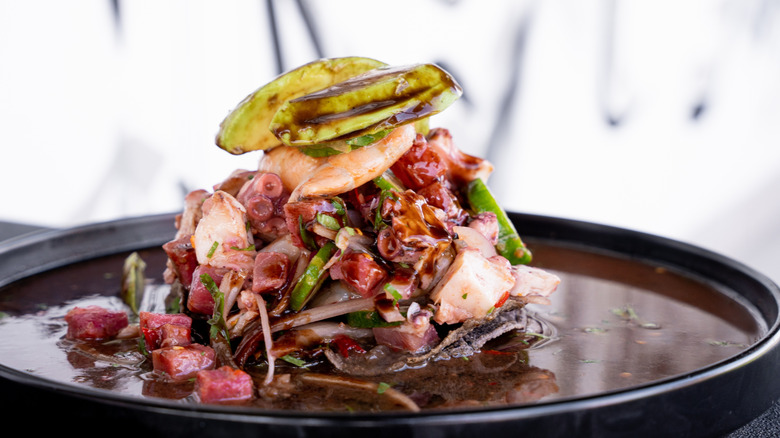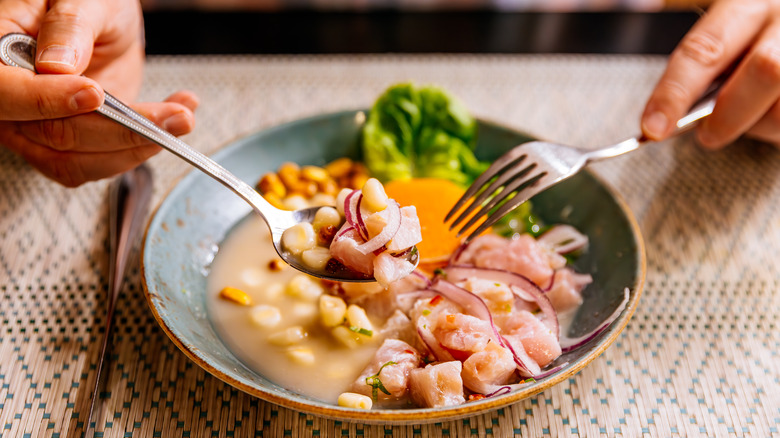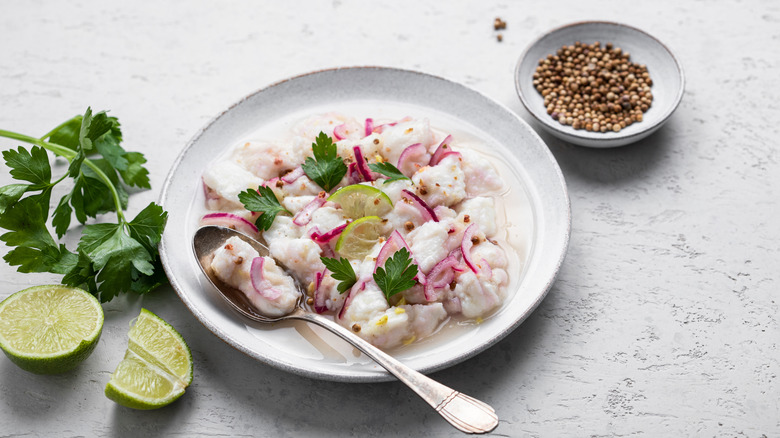The Ingredient Difference Between Mexican Vs Peruvian Ceviche
Fresh seafood is a wondrous culinary ingredient, and there are few better ways to showcase it than in a ceviche. At its most fundamental, the dish consists of cut up fish or shellfish thrown into a citrus-based sauce. The acid alters the composition of proteins, thereby firming up and darkening the flesh, just like heat-based cooking. Amplified with ingredients like chiles, fruit juice, herbs, onions, or sweet potatoes, it's a zesty and texturally captivating dish.
Ceviche appears in a myriad of traditional forms across Latin America. Its assembly varies among nearly every Pacific (and occasionally Atlantic country): from the southern point of Chile all the way up to Mexico. In the process, the dish takes on local flair, both through the employed seafood catch, and the accompanying flavors. There are many delicious interpretations, but cuisines especially noted for ceviche are Peru and Mexico, two renditions with quite a few differences. The former is a more minimalist take, with its focus on the aromatic marinating liquid called leche de tigre, while the latter incorporates more additions for a chunkier feel. The division is contentious — both countries lay claim to the origin of the dish. However, whichever one you try, expect a supremely delicious result.
Mexican ceviche comes with a larger range of components
A serving of Mexican ceviche visually resembles a vibrant salad. Additions like cucumber, tomato, onion, radishes, garlic, avocado, and peppers are all welcome in the mix. Everything is diced — including the seafood — and covered in an aromatic sauce. The seasoning liquid is lime based, but complemented with everything from lemon to hot sauce, Worcestershire sauce, and clam juice. And to top it off, expect some cilantro and a serving of tortilla chips, as is so common in the cuisine.
Evidently, variety is the common thread of Mexican ceviche, and the creative range of combinations is furthered by the many regional varieties. The most widespread version mixes white flesh fish or shrimp with a dependable trio of tomatoes, cucumbers, and onions, jalapeño, and lime juice, a take you'll find in Tijuana, Sonora, and often in the rest of the country.
Meanwhile in Sinaloa and Colima, chefs will grind the fish, and add in shredded carrots, as well as orange juice for flavor. The fine texture of the ceviche style is ideal atop a tostada, perhaps with a spritz of hot sauce or salsa atop. Sinaloa also offers an extra spicy version called aguachile. This rendition marinates shrimp in a small amount of lime juice, and tops with viciously hot peppercorn-like chiltepín peppers or serrano. So, to really sample the diversity of this country's ceviche, venture to several coastal destinations.
Peruvian ceviche emphasizes the marinade
In Peru, ceviche is oftentimes referred to as the national dish, making it one of the must-try Latin American favorites. Evidence suggests ceviche first originated here, crafted on Pacific shores as far back as 3,000 years ago. Today, ingredients have shifted a bit (like the introduction of citrus via the Columbian exchange), but the food nonetheless maintains a similar format. Large chunks of fish are marinated in a simple, but effective mix of lime juice, onions, chili peppers, and salt. Ginger, cilantro, and occasionally celery are included to amplify the aromatics. And to serve, there's boiled sweet potato and corn on the cob, as well as a cancha — a popular corn snack — and plantain chips, all for texture.
Otherwise, it's all about the careful balance of the marinade. There's a special emphasis in the flavor of the resultant liquid, which is called leche de tigre. Unique to this style, the milky-colored aromatic sauce is even served standalone at restaurants, a signifier of ceviche quality. Its palate comes down to the skill of the chef, as well as the vibrancy of Peruvian ingredients.
This Latin American ceviche style employs a distinct type of lime with a more potent acidity. In addition to its more biting flavor, the fruit's tartness decreases ceviche marination, altering the mechanics of the dish. Furthermore, the country employs its distinct ají chile, which brings both spice and sweet notes of tropical fruit.
The two cuisines employ different proteins in the dish
With such a large geographic gap between the two countries, it's no surprise the employed seafood differs, too. As with the variety of complementing ingredients, Mexican ceviche marinates larger variety of species. Shrimp is a common favorite, found in both nationwide interpretations as well as regional takes. In Sinaloa, the Pacific Sierra — a species in the mackerel family — is a common choice. Other candidates include mahi mahi, as well an extensive selection of white-fleshed fish, like halibut, tilapia, sea bass, and grouper. And other seafood selections aren't excluded from the ceviche mix: think crab, scallops, and even octopus. As long as it's fresh, the seafood's welcome in the ceviche platter.
Peruvian ceviche is more focused in its seafood selection, with most versions involving only one protein in the dish. The most traditional takes are made with sea bass (not to be confused with misleading Chilean sea bass), or bonito tuna. Today, a larger range of fresh, white-firmed fish are utilized, like fluke, flounder, sole, and grouper. And there are a few freshwater versions, like ceviche made with trout in the Andes, and paiche in the Amazon. Plus, chefs are experimenting with new combinations, crafting Japanese influenced mackerel, tuna and salmon interpretations, as well as even offering mushroom-based vegan versions. So, in either country, you'll be spoilt for choice — and all versions are worth a try.



